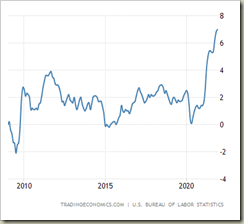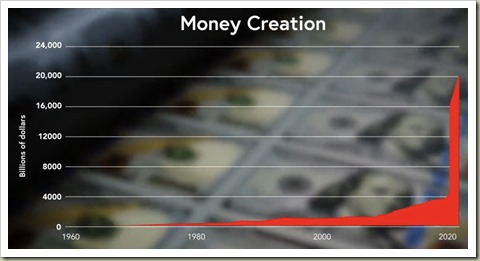Inflation Hot? Stop it with a recession or two. (Part 1)
Posted By RichC on February 11, 2022
 It is pretty obvious to most consumers that even with years of the Federal Reserve keeping interest rates low, printing money and Congress spending, inflation remained in check at under 2%. Unfortunately after the last round of easy money policies during the pandemic, business shutdowns and government giving away money, this is no longer true. Inflation has reared its ugly head big time and is now taking a significant bite out of paychecks and putting the pinch to family budgets. Where the cycle stop in the “prices going up” and “we need more pay and more government assistance” spiral … who knows?
It is pretty obvious to most consumers that even with years of the Federal Reserve keeping interest rates low, printing money and Congress spending, inflation remained in check at under 2%. Unfortunately after the last round of easy money policies during the pandemic, business shutdowns and government giving away money, this is no longer true. Inflation has reared its ugly head big time and is now taking a significant bite out of paychecks and putting the pinch to family budgets. Where the cycle stop in the “prices going up” and “we need more pay and more government assistance” spiral … who knows?
What we do know is that the last time inflation was running this hot, I was going to college, looking for a job, newly married and eventually trying to start a business. Thankfully I was relatively naïve and clueless to anything but living in inflationary times.
Last month I read a "A Grim History Repeats at the Fed" commentary in Barron’s Magazine that reviewed some of the economic goings-on during those days and what eventually had to be done to break the back of inflation. When heard that it eventually required “back to back recessions,” it seemed drastic … but then again after a decade of economists trying to bring inflation under control and failing, policies triggering recession is how the inflation spiral ended.
As Milton Friedman said in 1970, “Inflation is always and everywhere a monetary phenomenon.” Little has changed since then.
For most of the 1970s, Arthur Burns was chairman of the Federal Reserve Board. Inflation was rampant, just like now. Consumer price inflation averaged nearly 7% during his term. As Friedman diagnosed correctly, this rapid inflation was mainly caused by increases in the money supply of over 12% in the years 1971-72 and 1976-77. Instead, Burns attributed the price increases mainly to wage pressures, monopoly power, and the oil shock of the early 1970s.
Sound familiar? Inflation is again soaring, and the Fed blames supply constraints caused by the pandemic while neglecting to look at the increasing money supply as the main cause. It’s always easier to blame external factors rather than something that you control and have responsibility for.
I had the honor of serving under Chairman Paul Volcker on the Federal Reserve Board starting in 1986, when he was trying to bring inflation under control. President Jimmy Carter had appointed Volcker in August 1979 with the mandate to reduce the double-digit inflation rate. President Ronald Reagan confirmed this objective after he took office. With determination, Volcker raised the federal-funds rate to 20% by June 1981 and reduced the growth of the money supply. Not one, but two back-to-back recessions resulted.
The situation in Washington was tense while the monetary policy medicine took its course. But Volcker and the board prevailed and reduced the annual growth rate of the money supply from over 12.6% in 1979 to a much more reasonable 5.3% when he left the Fed in August 1987. Alan Greenspan continued the anti-inflationary policies. By the time I left the board in 1989, consumer price increases had moderated to only 4.6%.
The Fed was on its way to defeating inflation and keeping it under control for the rest of the century. The falling interest rates that accompanied the decline in inflation were a welcome side effect. These low rates supported decades of growth and prosperity.
Will it again .. and if so when will the next recession come? (see Part 2)

Comments